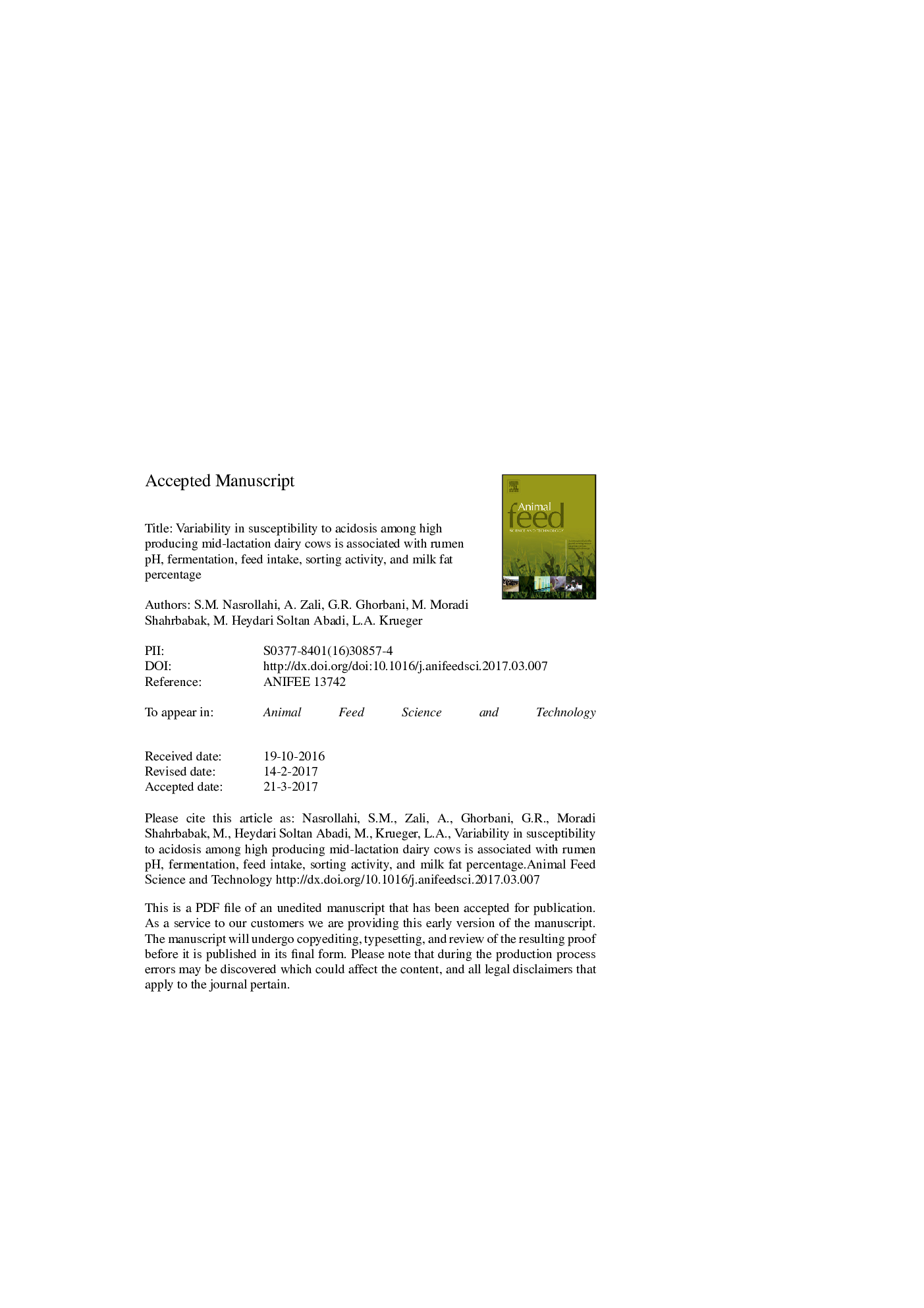| کد مقاله | کد نشریه | سال انتشار | مقاله انگلیسی | نسخه تمام متن |
|---|---|---|---|---|
| 5538906 | 1552358 | 2017 | 35 صفحه PDF | دانلود رایگان |
عنوان انگلیسی مقاله ISI
Variability in susceptibility to acidosis among high producing mid-lactation dairy cows is associated with rumen pH, fermentation, feed intake, sorting activity, and milk fat percentage
دانلود مقاله + سفارش ترجمه
دانلود مقاله ISI انگلیسی
رایگان برای ایرانیان
کلمات کلیدی
ADFDMIFCMNFCNDFDIM - اذعانAcetate - استاتacid detergent fibre - الیاف پاک کننده اسیدdays in milk - روز در شیرCoefficient of Variation - ضریب تغییرneutral detergent fibre - فیبر مواد شوینده خنثیdry matter - ماده خشکdry matter intake - مصرف ماده خشکcrude protein - پروتئین خامfat corrected milk - چربی اصلاح شده شیر
موضوعات مرتبط
علوم زیستی و بیوفناوری
علوم کشاورزی و بیولوژیک
علوم دامی و جانورشناسی
پیش نمایش صفحه اول مقاله

چکیده انگلیسی
The objectives of the current study were to evaluate the variation in susceptibility to subacute ruminal acidosis (SARA) among high producing, mid-lactation Holstein dairy cows fed a high-grain diet and to characterize animals that are rumen pH-tolerant to high-concentrate diets. Lactating dairy cows (n = 78, days in milk = 103 ± 26.5; body weight = 630 ± 76.8 kg) were fed a high-concentrate diet consisting of 35% forage and 65% concentrate. Cows were adapted for 14 d and then were sampled for 10 d. Rumen pH was measured by rumenocentesis for all cows at approximately 4 h after the morning feeding, and reticuloruminal pH was measured for 14 cows via indwelling sensors. Although all cows were fed the same diet, rumenocentesis pH and minimum reticuloruminal pH values ranged from 5.05 to 6.98 and 4.78-6.08, respectively, and the acidosis index ranged from 0 to 28 pH Ã min/kg of dry matter intake (DMI). Cows were classified according to rumenocentesis pH as tolerant (pH â¥Â 6.0; n = 26), marginal (5.8 â¤Â pH < 6; n = 21), and susceptible (pH < 5.8; n = 31). Cows were also classified according to reticuloruminal pH as susceptible if duration of an acidotic condition (pH < 5.8) exceeded 330 min/d (an average of 920 min/d; n = 9) and tolerant if the acidotic condition persisted <330 min/d (an average of 78 min/d; n = 5). The classification based on rumenocentesis pH revealed that DMI during first 2 h after morning feeding decreased with increasing SARA susceptibility (6.32 vs. 5.87 and 5.47 kg/d ± 0.28 for tolerant, marginal, and susceptible cows, respectively; P < 0.01). This result was associated with greater daily DMI of tolerant cows which also were of greater body weight, so intake per kg of body weight was not different among tolerant, marginal, and susceptible groups. Sorting against long particles and in favor of fine particles during the morning feeding (0-6 h) also increased with increasing SARA susceptibility (P < 0.01). However, when cows were classified according to reticuloruminal pH, DMI and sorting activity were not significant. Milk fat percentage was greater in tolerant cows, whereas total yield and yield of other components were not significant (P â¤Â 0.01). The proportions of isovalerate and valerate were correlated with increased SARA susceptibility in cows classified according to rumenocentesis pH (P = 0.03), but the rumen volatile fatty acid profile was not affected by SARA susceptibility when cows were classified by reticuloruminal pH. We conclude that DMI during the first 2 h after feeding, milk fat percentage, and valerate proportion in the ruminal fluid were the variables with the greatest correlation with ruminal pH (P â¤Â 0.05). These results indicate that substantial variation exists in SARA susceptibility among high producing, mid-lactation dairy cows, and that cows characterized as tolerant to the high-grain diet exhibit greater DMI and milk fat percentage, but decreased sorting behavior and proportion of isovalerate in the rumen.
ناشر
Database: Elsevier - ScienceDirect (ساینس دایرکت)
Journal: Animal Feed Science and Technology - Volume 228, June 2017, Pages 72-82
Journal: Animal Feed Science and Technology - Volume 228, June 2017, Pages 72-82
نویسندگان
S.M. Nasrollahi, A. Zali, G.R. Ghorbani, M. Moradi Shahrbabak, M. Heydari Soltan Abadi,